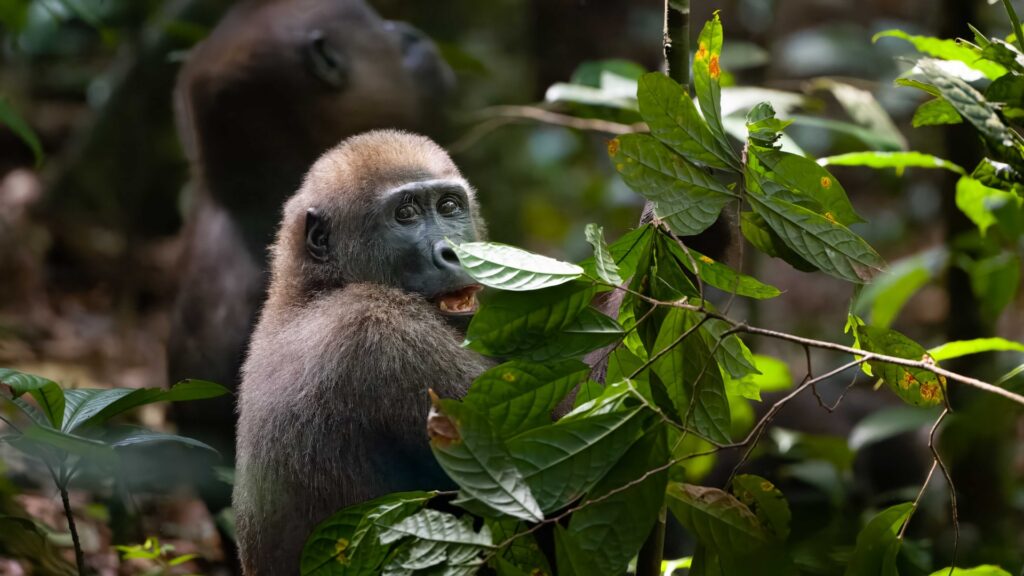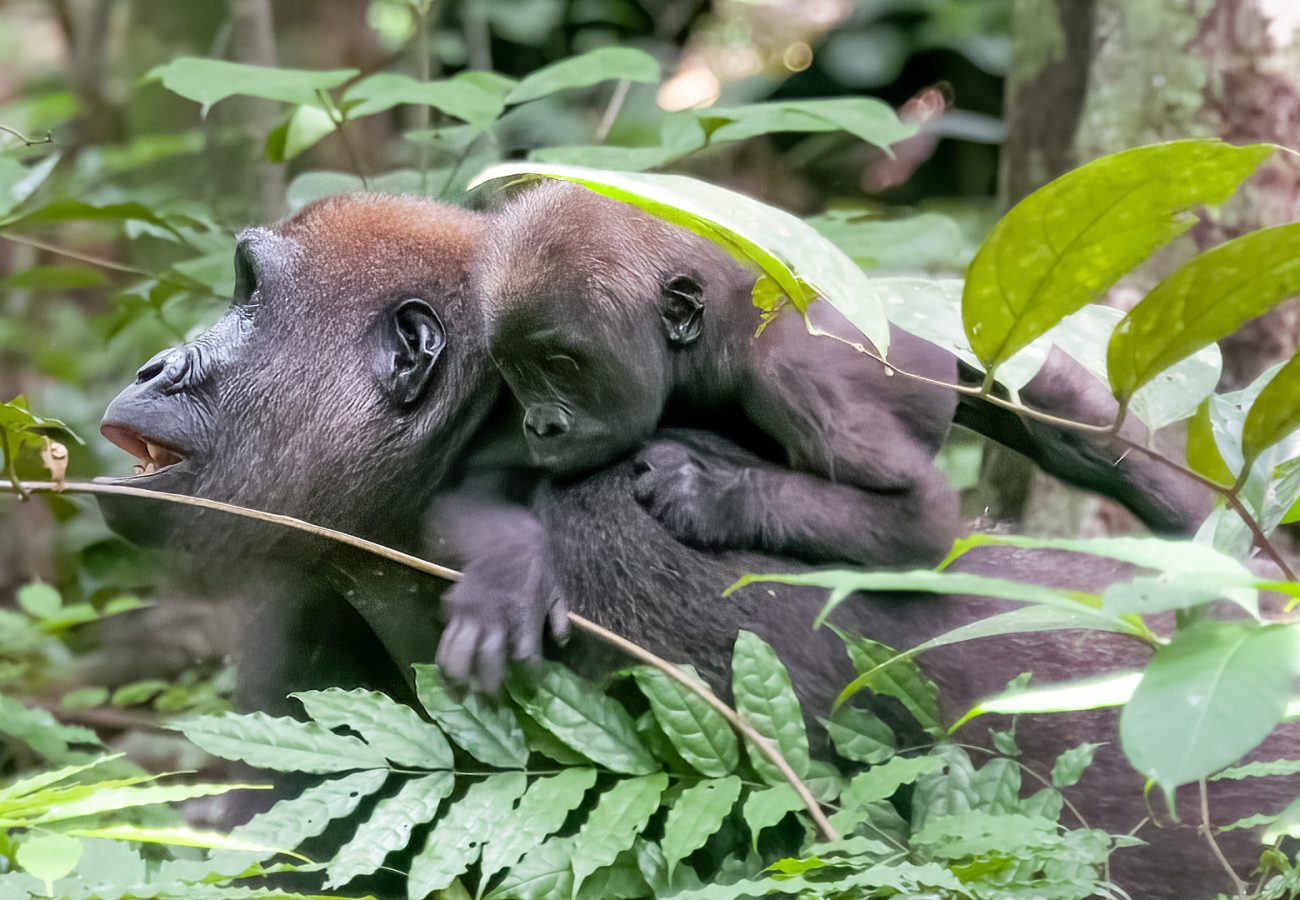32 Interesting Gorilla Facts for Kids and Curious Minds
Gorillas are great ape, in the same zoological family as chimpanzees, bonobos, orangutans and humans. Living in the rainforests of 10 African countries, from sea level to misty montane forests up to 13,000ft (4,000m), these fascinating primates have been studied by scientists for decades. Find out more about marvellous gorillas below!

(c) www.davecurrey.com
1. Gorillas are the largest of all primates
Gorillas are the biggest great apes, even larger than chimpanzees and orangutans. Male gorillas, called silverbacks, can weigh over 200 kg.
2. They share up to 98% of our DNA
Gorillas are one of our closest living relatives, after chimpanzees and bonobos. This genetic similarity also means they can catch some of the same illnesses humans get.
3. There are two species and four subspecies
Gorillas are split into two species: Eastern and Western gorillas. There are two subspecies of Eastern Gorilla: Mountain Gorillas and Grauer’s Gorilla and two species of Western Gorilla: Western Lowland Gorillas and Cross-River Gorillas.
4. The subspecies live in different areas
Each subspecies lives in a different region. Mountain Gorillas are found in the Virunga Mountains & Bwindi Forest, in Rwanda, the Democratic Republic of Congo and Uganda, Grauer’s Gorillas live in eastern Democratic Republic of Congo, Western Lowland Gorillas live in seven countries in Central Africa and Cross River Gorillas live in Nigeria and Cameroon.
5. All wild gorillas live in tropical Africa
Gorillas can only be found in the wild in the tropics of Africa. They tropical and montane habitats, such as bamboo, swamp and mixed forests.
6. Both species of gorilla are critically endangered
Gorillas are threatened by poaching, habitat loss and degradation, civil unrest and climate change. Despite it being illegal to hunt and kill gorillas, they are often targeted by poachers.
7. There are estimated to be just over 1,000 mountain gorillas left in the wild
Mountain Gorillas live in two separate (isolated) populations. One of these populations is in the Virunga Mountains, where it is estimated the total number of mountain gorillas fell to around only 250 individuals in the 1980s. Thanks to conservation efforts, this population is now estimated to be around 600 individuals. The second population, in the Bwindi-Sarambwe region, is estimated to be around 460 individuals.
8. Cross River Gorillas are severely threatened
There may fewer than 250 mature Cross River Gorillas remaining in the wild. This sub-species is restricted to the forests around the Cross River on the Cameroon-Nigeria border.
9. Western Lowland Gorillas have the biggest range of all the subspecies
The total range of Western Lowland Gorillas is almost 700,000km2. Most Western Lowland Gorillas live in the Republic of Congo, followed by Gabon and southwestern Cameroon, where Born Free works.
10. Gorillas have a unique noseprint
Gorillas have unique wrinkles above their nostrils which scientists have called their ‘noseprint’. These are used by researchers to identify the gorillas and keep a record of who is who.
11. Gorillas live in close-knit family groups
Gorillas are highly social animals that live in structured family groups. The composition of these groups varies by species. Western Gorilla groups are typically led by a dominant silverback male and include several adult females along with their offspring. These groups can be quite small—sometimes just two individuals—but may grow up to 20 members.
In contrast, Eastern Gorilla groups often include more than one adult male. Their average group size is around 10 independent individuals (excluding infants), but some groups can be much larger, with as many as 65 gorillas living together.
12. They build nests every night
Gorillas make sleeping nests from leaves and branches. Their nests are usually on the ground but sometimes they will build them in trees, or weave a springy bed in bamboo. Infants sleep in the same nest as their mothers to stay warm and safe. Researchers use gorilla nests to make population estimates, as they can count the number of nests in an area to get an idea of the group size.
13. Gorillas are gentle giants
Silverback gorillas are very strong and can tear down banana plants and small trees. But despite their strength, and their reputation, gorillas are peaceful, social animals. They only act aggressively when they feel threatened.
14. They love to eat
To feed their big bodies, gorillas spend a lot of time eating. How much time spent will depend on the environment, food availability and individuals. One study on Mountain gorillas found they could spend over 50% of their time feeding in a 12-hour period. Most of their diet is made up of leaves, stems, and shoots. But they also enjoy fruit (and they are important seed dispersal agents), bark, insects, flowers, rotting wood (which provides salt), and termite larvae.
15. Males are much bigger than females
Adult male gorillas can weigh twice as much as females. This is called ‘sexual dimorphism’ and is when there are big physical differences between males and females, such as body size, colour or vocalisations.
16. Gorillas are emotional and intelligent
Gorillas show emotions like joy and sadness. They laugh when tickled by other gorillas, play games, and even grieve when a family member dies.
17. They communicate using 16+ sounds
Gorillas use a variety of grunts, barks, hoots, and roars to talk to each other. Each vocalisation is used to communicate something with the other gorillas. Often, vocalisations are paired with a physical behaviour such as hoots and chest-beating, or laughing and a play-face, where a gorilla’s mouth is open but relaxed, not snarling aggressively.
18. Gorillas communicate using gestures
Research has shown that gorillas use gestures to communicate with each other, with these gestures having more than one use. One study found that gorillas knew over 100 different gestures, and that juvenile and adolescent individuals communicated most with gestures.
19. Koko the gorilla could use sign language
A famous gorilla named Koko is thought to have learned over 1,000 signs and understood more than 2,000 English words. Koko was born in San Fransico Zoo, then spent the rest of her life at the Gorilla Foundation in California, where her (and two other gorillas’) language skills were studied. Whilst it is impressive that a gorilla can learn human language, she was living in an unnatural environment in captivity. Born Free advocates to keep wildlife in the wild, where they belong, as does the Gorilla Foundation.
20. Gorillas aren’t territorial
Unlike chimpanzees, who are highly territorial, gorilla group ranges can have a large overlap. Eastern gorilla home range size is estimated to be between 6 – 40km2 (2.3 – 15.4 miles2).
21. Their arms are longer than their legs
This helps them walk on all fours using a special movement called “knuckle-walking.” Knuckle-walking is when an ape walks on their knuckles instead of the palm of their hands. Chimpanzees and bonobos also knuckle walk. Despite a gorilla’s arms being longer than their legs, they have more muscles in their legs, making them heavier in weight.
22. Males are called blackbacks before becoming silverbacks
Between the ages of 8 and 12, young males are known as blackbacks because the hair on their back is black. Once they mature, they develop the silver saddle on their backs and become silverbacks.
23. Both male and female gorillas disperse
When gorillas reach maturity, they typically disperse from their natal group (the group they were born into). Females will migrate into another group. Males usually leave to live alone or occasionally in small, all-male “bachelor” groups before trying to join a new group. To lead a group, a male must either attract dispersing females and form a new group or take over an existing group by challenging the dominant silverback.
24. Female gorillas give birth only every four to five years
Their gestation period is approximately 8.5 months. Gorillas, like all great apes, have slow life histories. This means that they take a long time to mature compared to other animals their size, and this leads to long inter-birth intervals (the length of time between a female’s babies).
25. Western Gorilla males don’t reach maturity until they are 18 years old
Female Western Gorillas have their first infants around 11 years old, while males take longer to reach full maturity. Western Gorillas are slower to reach maturity than Eastern Gorillas.
26. Gorillas and Chimpanzees can share habitat
Gorillas share a lot of their range with chimpanzees, where the two great apes can live together. Researchers previously thought the two species would avoid each other but one study has found that they do overlap on occasions and interspecies interactions can occur.
27. Threats include habitat loss and poaching
Gorillas face many threats, including poaching, deforestation, farming, snares, disease, and poorly managed tourism. Habitat loss means they sometimes raid crops like maize and the pith (core) of banana plants for food, which can cause conflict with farmers.
28. Conservation efforts are working
Thanks to international conservation work, mountain gorilla populations are slowly rising. But they still need our help and remain under serious threat. Where effective conservation efforts have been put in place, populations are stable or rising but more needs to be done to protect these magnificent animals. Born Free’s Guardians of Dja programme in Cameroon is working with communities to protect the gorillas living in and around the Dja Faunal Reserve.
29. Dr Dian Fossey is one of the most famous gorilla researchers
She studied Mountain Gorillas in Rwanda and the Democratic Republic of Congo, over a 19 year period, raised awareness about the dangers these populations faced. Dr Fossey actively fought against poaching, which was destroying mountain gorilla population, against cattle grazing in the park and against deforestation for agriculture. She was murdered in 1985 but her legacy in Rwanda, DRC and Uganda in Mountain Gorilla conservation continues today. Born Free’s own Ian Redmond was her assistant in the late 1970s and was involved in the filming of ‘Gorillas in the Mist’, a movie starring Sigourney Weaver, which tells Dian’s story.
30. They are our allies in the fight against climate change
The forests where gorillas evolved also need gorillas! They prune trees, fertilise soil with their dung and are second only to elephants in their importance as seed dispersal agents. The forests of Africa are essential drivers of global weather patterns and sequester and store gigatonnes of carbon, ecosystem services enhanced by primates and elephants.
31. Western lowland gorillas are the most common subspecies found in zoos
A lot of research has been done on gorillas in zoos, but this cannot be used to relate to wild populations as zoos are artificial environments, not suitable for great apes.
32. Gorillas belong in the wild
Despite their popularity in zoos and suggested conservation importance of keeping gorillas in zoos, captivity is not a suitable environment for gorillas. They need to be able to live freely in the wild, where they belong.

JUNGLE NOT JAIL FOR OUR CLOSEST COUSINS
Will you stand up for great apes and pledge never to visit a facility which keeps them captive for entertainment?
